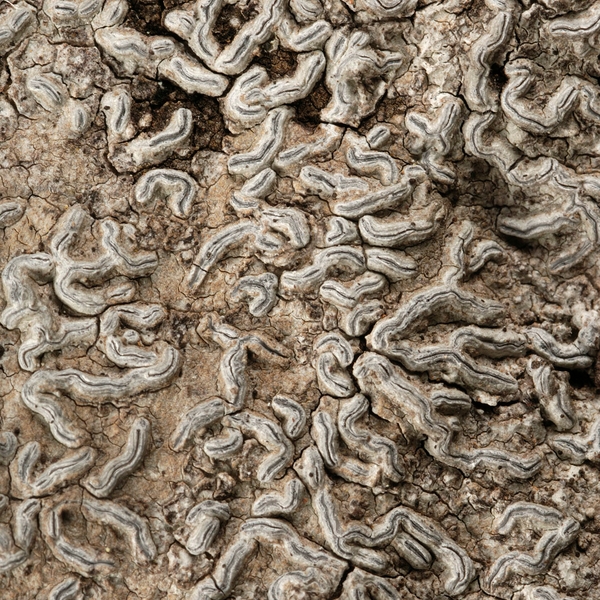Galapagos Species Database
The Galapagos Species Database shares the information about the species from our Natural History Collections.
Graphis acharii
liquen de escritura, Script lichen



Thallus thin, continuous to rimose, lead gray to whitish gray; surface smooth, not pruinose; Apothecia prominent to sessile, lirellate; lirellae broad, elongate, moderately to sparsely branched; labia thick, broad, blackened, entire, becoming striate with age (see notes), almost entirely covered by a smooth, gray thallus layer that may in parts erode with age; disc concealed, a thin slit; exciple completely carbonized, carbonization extending below the hymenium; hymenium hyaline, clear (not inspers), I–, or I+ weakly blue along the lateral exciple; ascospores hyaline, I+ bluish violet, (1-)2-6 per ascus, narrowly oblong to fusiform, 100-170 x 20-35 µm, muriform, 20-33 vs. 3-4 celled. Chemistry: No substances found; all spot tests negative (if K+ orange, with norstictic acid check G. vestitoides).
Staiger (2002) synonymized Graphis inturgescens with G. acharii, but according to Lücking et al. (2008) the two taxa are distinct species: Graphis acharii with striate labia vs. G. inturgescens with labia remaining entire. In Galapagos striation develops only with age and is often not present in juvenile specimens. Lücking et al. (2008) emphasize that G. inturgescens s.str. is further characterized by thickly covered lirellae similar to G. illinata Eschw. Galapagos material lacking distinct labia striation, have lirellae covered by a very thin thallus only. These lirellae are apically blackish gray and the specimens are therefore here interpreted as immature G. acharii. In the literature G. acharii is reported as corticolous, but in Galapagos specimens have also been found on hard basalt lava at steep, sheltered and shaded vertical cliff faces. Formally this saxicolous material keys out as G. crystallifera in Staiger (2002). However, the Galapagos specimens do not agree well with the detailed description of G. crystallifera provided there. Galapagos material has larger spores with fewer longitudinal septa and a more strongly carbonized lateral exciple than G. crystallifera sensu Staiger (2002). Although both species grow saxicolously, the exposed compacted soil and sandstone, where G. crystallifera can be found in Brazil, represents a significantly different habitat from sheltered, shaded basalt cliffs where G. acharii has been found on the Galapagos. The saxicolous specimens in Galapagos are morphologically and anatomically very similar to corticolous material of G. acharii; they are treated here as a saxicolous form of this species.
Domain
Eukaryota
Kingdom
Fungi
Phylum
Ascomycota
Class
Lecanoromycetes
Order
Ostropales
Family
Graphidaceae
Genus
Graphis
Species
acharii
Taxon category: Accepted
Taxon origin: Native
Map of specimen collection localities or observation records for this species in our collections database.
Distribution: A gondwanan species; new to Galapagos, moderately common throughout the humid zone, typically corticolous, on a wide variety of different trees and shrubs like Croton scouleri, Psidium guajava, P. galapageium, Zanthoxylum fagara, Chiococca alba, Scalesia pedunculata, Cordia alliodora, and Cinchona p
- Bungartz, F. Lücking, R. & Aptroot, A. (2009) The lichen family Graphidaceae (Ostropales, Lecanoromycetes) in the Galapagos Islands. Nova Hedwigia 90: 1-44.


